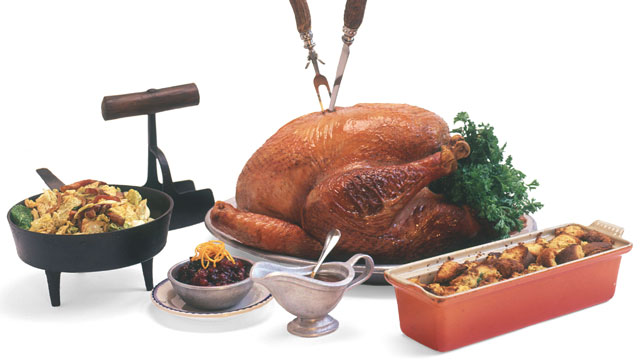Turkeys were plentiful in England before 1550, having made their way to Europe on Spanish ships transporting them from Mexico. Therefore, British colonists were already in possession of recipes for turkey before they landed in the New World, where they would find flocks of up to 5,000 wild turkeys gathered by certain rivers, making a veritable feast for starving émigrés. In addition to boiling, frying, and baking them, roasting was one of the most common means of preparing turkey in colonial times. Amelia Simmons’ recipe in American Cookery calls for stuffing the bird with bread stuffing, roasting, and basting it. In what may have set the precedent for the modern Thanksgiving, she instructs the cook to serve the turkey with “cramberry-sauce” and mashed potatoes.
From The City Tavern Cookbook: Recipes from the Birthplace of American Cuisine ©2009 by Walter Staib
Ingredients
- 1 (18- to 20-pound) turkey, with giblets
- Salt and freshly ground black pepper
- 1 medium yellow onion, quartered
- 1/4 cup chopped fresh parsley
- 2 tablespoons chopped fresh thyme
- 2 tablespoons dried rubbed sage
- 2 medium shallots, finely chopped
- 11/2 tablespoons olive oil
- 1 cup imported Madeira
- 1 medium yellow onion, coarsely chopped
- 2 large carrots, peeled and chopped
- 2 celery ribs, chopped
- 1/4 cup dry white wine, such as Sauvignon Blanc
- 3 cups chicken stock
- 11/2 tablespoons cornstarch
Directions
- Preheat the oven to 325°F. Place an oven rack on the bottom level. Place a wire roasting rack in a large roasting pan and spray it with vegetable cooking spray.
- Remove the giblets and neck and any visible fat from the turkey cavity and reserve for the giblet stock. Discard the liver and fat. Rinse the turkey inside and out with cold water and pat dry with paper towels.
- Sprinkle the turkey cavity with salt and pepper. Place the quartered onion in the cavity.
- In a small bowl, combine the parsley, thyme, sage, shallots, and 1 tablespoon of the oil. Sprinkle with salt and a generous grinding of pepper.
- With your fingers, separate the turkey skin from the breast meat, taking care not to tear the skin or pierce the meat. Rub the herb mixture on the meat under the skin on each side of the breastbone. Tie the drumsticks together with kitchen string and twist the wing tips behind the back. Place the turkey, breast side up, in the prepared roasting pan.
- Roast the turkey for about 2 hours, until the breast is browned. Cover the turkey with aluminum foil and roast for 3 to 4 hours, until a meat thermometer inserted in a thigh muscle registers 185°F. Add 1/2 cup of the Madeira, and baste the turkey every 15 minutes.
- While the turkey roasts, heat the remaining 1/2 tablespoon oil in a large saucepan over medium heat, add the coarsely chopped onion, the carrots, celery, and reserved giblets and neck, and cook, stirring frequently, for about 15 minutes, until the giblets, onion, carrots, and celery are well browned. Add the white wine to deglaze the pan, scraping up the browned bits on the bottom of the pan with a wooden spoon. Cook for about 1 minute, until it comes to a boil. Add the stock and bring back to a boil over high heat. Reduce the heat to low, partially cover the pan, and simmer for 30 minutes.
- Strain the giblet stock through a fine sieve into a medium bowl (you should have about 2 cups). Chop the giblets and add them back into the stock. Bring to room temperature, then cover and refrigerate until ready to use.
- When the turkey is done, transfer it to a carving board, loosely cover it with aluminum foil, and let it rest for 15 to 20 minutes before carving.
- While the turkey rests, pour the drippings from the roasting pan through a fine sieve into a small bowl. Place the bowl in the freezer for about 20 minutes to solidify the fat.
- Meanwhile, set the roasting pan back on the stovetop over medium heat. Add the rest of the Madeira to deglaze the pan, scraping up any browned bits on the bottom of the pan with a wooden spoon. Cook for about 1 minute, until it comes to boil. Strain the liquid through a fine sieve into a medium saucepan.
- Skim the fat from the chilled drippings and discard. Add the drippings to the Madeira mixture in the saucepan. Add the reserved giblet stock and giblets. Bring to a simmer over medium heat.
- In a small bowl, dissolve the cornstarch in 2 tablespoons cold water. Slowly add to the simmering Madeira mixture, whisking until the gravy thickens slightly. Season with salt and pepper to taste.
- Remove the string from the turkey and carve (see directions below). Serve with the warm Madeira gravy.
Tips/Techniques
Chef’s Note: Carving a Turkey - Once you learn a few basic cuts, you’ll get the carving right, every time. Using a carving knife and fork, cut between the lower part of the breast and the thigh, pushing down until the leg joint separates. Wiggle each leg to find the joint between the thigh and the drumstick and slice downward through the joint. Slice the meat off the bones. Bend each wing to find the joint, then cut straight downward to remove the wing. Make a long cut along one side of the breastbone. Carve the meat from the breast, working toward the first cut in smooth, even slices.





Search or Browse Recipes
Course
Cuisine
Occasion
Theme